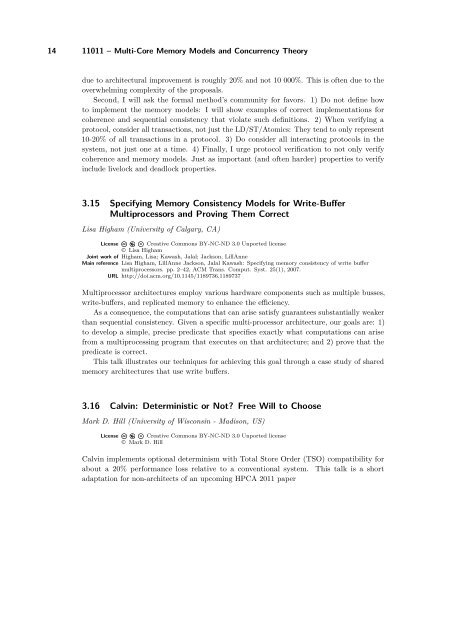Volume 1, Issue 1, January 2011 - DROPS - Schloss Dagstuhl
Volume 1, Issue 1, January 2011 - DROPS - Schloss Dagstuhl
Volume 1, Issue 1, January 2011 - DROPS - Schloss Dagstuhl
Create successful ePaper yourself
Turn your PDF publications into a flip-book with our unique Google optimized e-Paper software.
14 11011 – Multi-Core Memory Models and Concurrency Theory<br />
due to architectural improvement is roughly 20% and not 10 000%. This is often due to the<br />
overwhelming complexity of the proposals.<br />
Second, I will ask the formal method’s community for favors. 1) Do not define how<br />
to implement the memory models: I will show examples of correct implementations for<br />
coherence and sequential consistency that violate such definitions. 2) When verifying a<br />
protocol, consider all transactions, not just the LD/ST/Atomics: They tend to only represent<br />
10-20% of all transactions in a protocol. 3) Do consider all interacting protocols in the<br />
system, not just one at a time. 4) Finally, I urge protocol verification to not only verify<br />
coherence and memory models. Just as important (and often harder) properties to verify<br />
include livelock and deadlock properties.<br />
3.15 Specifying Memory Consistency Models for Write-Buffer<br />
Multiprocessors and Proving Them Correct<br />
Lisa Higham (University of Calgary, CA)<br />
License Creative Commons BY-NC-ND 3.0 Unported license<br />
© Lisa Higham<br />
Joint work of Higham, Lisa; Kawash, Jalal; Jackson, LillAnne<br />
Main reference Lisa Higham, LillAnne Jackson, Jalal Kawash: Specifying memory consistency of write buffer<br />
multiprocessors. pp. 2–42, ACM Trans. Comput. Syst. 25(1), 2007.<br />
URL http://doi.acm.org/10.1145/1189736.1189737<br />
Multiprocessor architectures employ various hardware components such as multiple busses,<br />
write-buffers, and replicated memory to enhance the efficiency.<br />
As a consequence, the computations that can arise satisfy guarantees substantially weaker<br />
than sequential consistency. Given a specific multi-processor architecture, our goals are: 1)<br />
to develop a simple, precise predicate that specifies exactly what computations can arise<br />
from a multiprocessing program that executes on that architecture; and 2) prove that the<br />
predicate is correct.<br />
This talk illustrates our techniques for achieving this goal through a case study of shared<br />
memory architectures that use write buffers.<br />
3.16 Calvin: Deterministic or Not? Free Will to Choose<br />
Mark D. Hill (University of Wisconsin - Madison, US)<br />
License Creative Commons BY-NC-ND 3.0 Unported license<br />
© Mark D. Hill<br />
Calvin implements optional determinism with Total Store Order (TSO) compatibility for<br />
about a 20% performance loss relative to a conventional system. This talk is a short<br />
adaptation for non-architects of an upcoming HPCA <strong>2011</strong> paper













